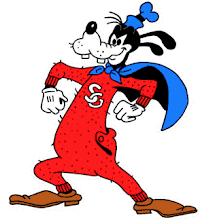
Thanks to the folks over at Internet Archive, here's the first 75 episodes of the classic Adventures of Superman Old Time Radio Show....enjoy!
Download Link




 When I was a kid, I was infatuated with this line of toys...I mean, it was the first time in my young existence that I could actually own toys based upon my great love: comic books.
When I was a kid, I was infatuated with this line of toys...I mean, it was the first time in my young existence that I could actually own toys based upon my great love: comic books.
In 1984, DC Comics awarded the license of their characters to Kenner Toys, hot on the heels of Mattel's "action feature" heavy He-Man toy line. Winning the license away from Mego Corporation and Mattel with their emphasis on action and art, Kenner devised hidden mechanisms within the figures that would trigger an action when the figures legs or arms were squeezed. This emphasis on each figure's "super power" led to the naming of the line - The Super Powers Collection. Each figure in the first two series were also packaged with a mini-comic featuring that character's adventures.
Comic creator Jack Kirby received some of the only royalties of his long career for redesigning his characters for Kenner. Artist George Pérez also received royalties for his design of Cyborg and redesign of Lex Luthor and Brainiac. Most all other designs (and much of the packaging artwork) is based on José Luis García-López's classic DC Style Guides (other artwork used appears to be the work of Dick Giordano).
In all, three series of figures and accessories were released (in 1984, 1985, and 1986), but after three years of production the line collapsed. Coincidentally, Kenner's Star Wars line stopped shipping to stores the same year the Super Powers line ended.
After 10 years of chronicling the history of the Super Powers Collection, in 2003 toy historian Jason Geyer's ToyOtter website revealed the never seen designs for the unmade Series Four, Five, and Six, along with vehicles, playsets and a deluxe "Power Plus" figure line. The most famous of these is the Man-Bat figure, of which an actual prototype was created.
Prior to Super Powers, one manufacturer (in this case, the Mego Corporation) licensed both DC and Marvel characters for action figures. When the Secret Wars toyline, by Mattel, came onto the retail toy scene, it was setup as direct competition for the Kenner line. These figures, similar in scale to the Super Powers Collection, introduced a competing marketing strategy between manufacturers of Marvel and DC action figures, continuing to separate the comic book publishers' character licenses. That trend continues to this day.
The Super Powers line, in many ways, inspired the 1989 Toy Biz DC Super Heroes toyline in design. This line, merging with the Batman toyline would borrow design elements from many of the Kenner figures, most notably Superman, Robin, and Penguin who were near identical copies of the Kenner figures.
Mattel's DC Universe Classics line also draws inspiration from the Super Powers figures. Several figures that were redesigned for the Super Powers line (Mantis, Parademon, and Steppenwolf) were produced for DC Universe Classics in both comic-accurate and Super Powers-accurate versions. A Cyclotron figure is also being released, even though the character only appeared as part of the Super Powers line.
Based on definitive style guide artwork, with moderate articulation and hidden action features, the Kenner Super Powers Collection eventually released 34 figures, eight vehicles, and one playset. In addition, Latin and South American toymakers introduced three characters not available in the US. In Argentina, toy company Pacipa (and later Play Ful) produced El Acertijo (Riddler), which was a Green Lantern figure in different paint. It was released in Argentina under the Super Amigos (Super Friends) brand. Brazilian toy company Gulliver produced El Capitan Rayo (Captain Lightning, but sometimes anglicized simply 'Captain Ray'), and his unique nemesis 'Hombre de las Nieves' (Yeti/The Abominable Snowman). Though most Gulliver Super Powers characters were branded 'Super Powers' (the characters that Kenner also made), the unique Rayo and Yeti were released under the 'Super Heroes' brand to distinguish them. They were available in Colombia.
 To continue with this lazy day of multiple post, I present some reprints from Charlton's great "Last Gasp" period of publishing (around 1985, after one last attempt at comic book publishing, Charlton finally gave up the ghost). This time it's Thane of Balgarth, a neat little sword and sorcery title with early work by Jim Aparo...
To continue with this lazy day of multiple post, I present some reprints from Charlton's great "Last Gasp" period of publishing (around 1985, after one last attempt at comic book publishing, Charlton finally gave up the ghost). This time it's Thane of Balgarth, a neat little sword and sorcery title with early work by Jim Aparo...


